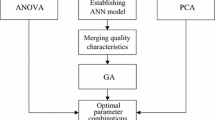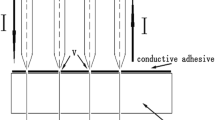Abstract
Due to increasing environmental consciousness, the European Union has prohibited the use of lead substances in electronics soldering material. 58Bi/42Sn solder with a melting temperature of only \(138^{\,\circ }\)C helps achieve a lower process temperature to resolve the board warpage issue. Curing the adhesive simultaneously with solder reflow helps simplify the assembly process and reduces the manufacturing cost. When a low soldering temperature profile is used, the impact on the adhesion performance of the cured adhesive becomes a major concern. This research investigates the influence of adhesive dispensing process parameters on the shear strength of 0805 chip capacitors. Experimental data is analyzed using the principal component analysis (PCA) technique and PCA integrated with grey relational analysis algorithm. This study also proposes an innovative parametric design for artificial neural network (ANN) modeling for the multi-quality function problem to determine the optimal process scenarios. Results of the confirmation test indicate that the samples prepared using the process parameters identified by ANN are superior to the others. Thus, the optimal process parameters are adhesive dispense location beneath the component body, placement time of 0 s, a curing temperature of \(160^{\,\circ }\)C and a conveyor speed of 1 m/min. The implementation of the optimal process has improved chip capacitor fall-off from 2.5 to 0.88 %.









Similar content being viewed by others
References
Biswasa, S., & Satapathya, A. (2010). A study on tribological behavior of alumina-filled glass-epoxy composites using taguchi experimental design. Tribology Transactions, 53, 520–532.
Brodsky, W. L., Parker, F. D., & Shoenthaler, D. (1980). Development of a 68-Pin multiple in-line package. IEEE Transactions on Components, Hybrids, and Manufacturing Technology, 3(4), 594–601.
Chan, K. Y., Kwong, C. K., & Tsim, Y. C. (2010). Modelling and optimization of fluid dispensing for electronic packaging using neural fuzzy networks and genetic algorithms. Engineering Applications of Artificial Intelligence, 23, 18–26.
Chen, X. B., & Kai, J. (2004). Modeling of positive-displacement fluid dispensing processes. IEEE Transactions on Electronics Packaging Manufacturing, 27(3), 157–163.
Chen, X. B., Li, M. G., & Cao, N. (2009). Modeling of the fluid volume transferred in contact dispensing processes. IEEE Transactions on Electronics Packaging Manufacturing, 32(3), 133–137.
Chen, T., & Wang, Y. C. (2010). An evolving hybrid neural approach for predicting job completion time in a semiconductor fabrication plant. European Journal of Industrial Engineering, 4, 336–354.
Chiang, K. T., & Chang, F. P. (2006). Optimization of the WEDM process of particle-reinforced material with multiple performance characteristics using grey relational analysis. Journal of Material Processing Technology, 180, 96–101.
Deng, G., Cui, H. X., Peng, Q. F., & Zhong, J. (2005). Experiment study influences of some process parameters on dispensing dots consistency in contact dispensing process (pp. 1–7). Changsha, China: Conference on High Density Microsystem Design and Packaging and Component Failure Analysis.
Dorofki, M., Elshafie, A. H., Jaafar, O., Karim, O. A., & Mastura, S. (2012). Comparison of artificial neural network transfer functions abilities to simulate extreme runoff data (vol. 33, pp. 39–44). Singapore: International Conference on Environment, Energy and Biotechnology.
Girish, W., Chu, Q., & Damodaran, P. (2006). Wave soldering using Sn3.0 Ag0.5 Cu solder and water soluble VOC-free flux. IEEE Transactions on Electronics Packaging Manufacturing, 29(3), 202–210.
Huang, C. Y. (2010). Reducing solder paste inspection in surface mount assembly through Mahalanobis-Taguchi analysis. IEEE Transactions on Electronics Packaging Manufacturing, 33(4), 265–274.
Huang, C. Y., & Huang, H. H. (2012). Process optimization of SnCuNi soldering material using artificial parametric design. Journal of Intelligent Manufacturing. doi:10.1007/s10845-012-0720-z.
Huang, C. Y., Huang, H. H., & Ying, K. C. (2012). Sn-Cu-Ni soldering process optimization using multivariate analysis. IEEE Transactions on Components, Packaging and Manufacturing Technology, 2(3), 527–535.
Hwang, S. J. (2002). Effects of process parameters on the mold adhesion force in IC encapsulation process. In 8th International symposium on advanced packaging materials.
Li, X., Ye, N., Xu, X., & Sawhey, R. (2007). Influencing factors of job waiting time variance on a single machine. European Journal of Industrial Engineering, 1(1), 56–73.
Li, M. H. C., Al-Refaie, A., & Yang, C. Y. (2008). DMAIC approach to improve the capability of SMT solder printing process. IEEE Transactions On Electronics Packaging Manufacturing, 31(2), 126–133.
Liu, X. Y., Ma, H. T., Zhao, J., & Wang, L. (2005). The evaluation of Sn-58Bi composite solder mixed with \(\text{ Y }_{2} \text{ O }_{3}\). Shanghai, China: Conference on High Density Microsystem Design and Packaging and Component Failure Analysis.
Liu, Sheng, & Mei, Yuhai. (1995). Behavior of delaminated plastic IC packages subjected to encapsulation cooling, moisture absorption, and wave soldering. IEEE Transactions on Components, Packaging, and Manufacturing Technology, 18(3), 634–645.
Lu, H. S., Chang, C. K., Hwang, N. C., & Chung, C. T. (2009). Grey relational analysis coupled with principal component analysis for optimization design of the cutting parameters in high-speed end milling. Journal of Materials Processing Technology, 209, 3808–3817.
Markopoulos, A. P., Manolakos, D. E., & Vaxevanidis, N. M. (2008). Artificial neural network models for the prediction of surface roughness in electrical discharge machining. Journal of Intelligent Manufacturing, 19, 283–292.
Raissi, S., & Farsani, R. E. (2009). Statistical process optimization through multi-response surface methodology. World Academy of Science, Engineering and Technology, 51, 267–271.
Rumelhart, D. E., & McClelland, J. L. (1986). Parallel distributed processing: Explorations in the micro-structure of cognition (Vol. 1). Cambridge, MA: MIT Press. 1.
Sadeghi, B. H. M. (2000). A BP-neural network predictor model for plastic injection molding process. Journal of Materials Processing Technology, 103(3), 411–416.
Shokir, E. M. (2001). Neural network determines shaly-sand hydrocarbon saturation. Oil Gas Journal, 99(17), 37–41.
Shokir, E. M., Goda, H. M., Fattah, K. A., & Sayyouh, M. H. (2004). Modeling approach for predicting PVT data. Engineering Journal of the University of Qatar, 17, 11–28.
Sibalija, T. V., & Majstorovic, V. D. (2012). An integrated approach to optimise parameter design of multi-response processes based on Taguchi method and artificial intelligence. Journal of Intelligent manufacturing,. doi:10.1007/s10845-010-0451-y.
Su, C. T., & Tong, L. I. (1997). Multi-response robust design by principal component analysis. Total Quality Management, 8(6), 409–416.
Su, C. T., & Chiang, T. L. (2003). Optimizing the IC wire bonding process using a neural networks/genetic algorithms approach. Journal of Intelligent Manufacturing, 14(2), 229–238.
Sun, R., Tsung, F., & Qu, L. (2007). Evolving kernel principal component analysis for fault diagnosis. Computers and Industrial Engineering, 53, 361–371.
Tarng, Y. S., Juang, S. C., & Chang, C. H. (2002). The use of Grey-Based Taguchi methods to determine submerged arc welding process parameters in hardfacing. Journal of Materials Processing Technology, 128(1–3), 1–6.
Thamizhmanii, S., Saparudin, S., & Hasan, S. (2007). Analyses of surface roughness by turning process using Taguchi method. Journal of Achievements in Materials and, Manufacturing Engineering, 20.
Tong, L. I., & Wang, C. H. (2002). Multi-response optimization using principal component analysis and grey relational analysis. International Journal of Industrial Engineering, 9(4), 343–350.
Tsai, T. N. (2009). Modeling and optimization of reflow thermal profiling operation: A comparative study. Journal of the Chinese Institute of Industrial Engineers, 26(6), 480–492.
Tsai, C. W., Tong, L. I., & Wang, C. H. (2010). Optimization of multiple responses using data envelopment analysis and response surface methodology. Tamkang Journal of Science and Engineering, 13(2), 197–203.
Wable, G., Quyen, C., Damodaran, P., & Srihari, K. (2006). Wave soldering using Sn/3.0Ag/0.5Cu solder and water soluble VOC-Free flux. IEEE Transactions on Electronics Packaging Manufacturing, 29(3), 202–210.
Wang, J., Wen, L., Zhou, J., & Chung, M. (2011). Mechanical properties and joint reliability improvement of Sn-Bi alloy. Samsung Semiconductor (China) R &D Institute, 15, 492–496.
Wang, G., Wang, Y., Zhao, J., & Chen, G. (2012). Process optimization of the serial-parallel hybrid polishing machine tool based on artificial neural network and genetic algorithm. Journal of Intelligent Manufacturing, 23, 365–374.
Yang, T., Tsung-Nan Tsai, T. N., & Yeh, J. (2005). A neural network-based prediction model for fine pitch stencil-printing quality in surface mount assembly. Engineering Applications of Artificial Intelligence, 18, 335–341.
Zhu, Q. S., Zhang, Z. F., Wang, Z. G., & Shang, J. K. (2008). Inhibition of interfacial embrittlement at SnBi/Cu single crystal by electrodeposited Ag film. Journal of Materials Research, 23(1), 78–82.
Author information
Authors and Affiliations
Corresponding author
Rights and permissions
About this article
Cite this article
Huang, CY. Innovative parametric design for environmentally conscious adhesive dispensing process. J Intell Manuf 26, 1–12 (2015). https://doi.org/10.1007/s10845-013-0755-9
Received:
Accepted:
Published:
Issue Date:
DOI: https://doi.org/10.1007/s10845-013-0755-9




